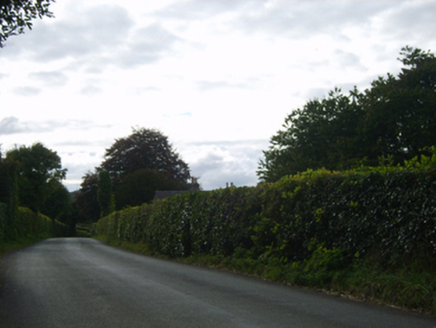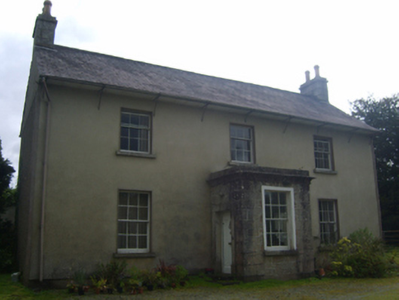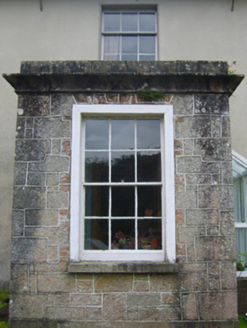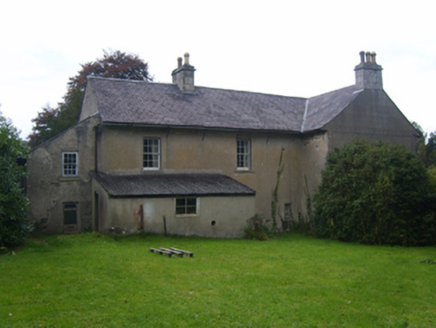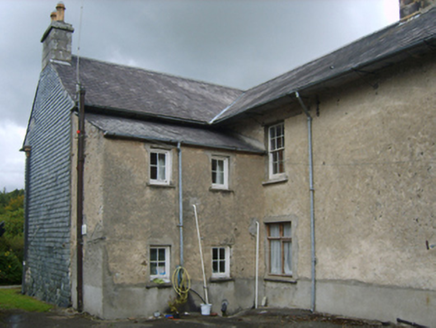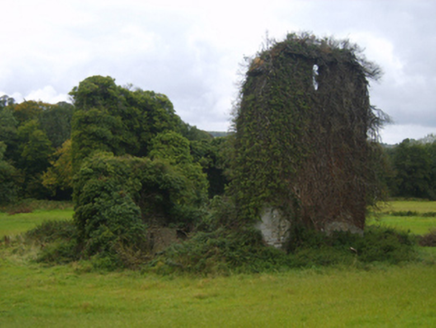Survey Data
Reg No
15700404
Rating
Regional
Categories of Special Interest
Architectural, Artistic, Historical, Social
Original Use
House
In Use As
House
Date
1745 - 1750
Coordinates
291685, 160461
Date Recorded
28/09/2007
Date Updated
--/--/--
Description
Detached three-bay two-storey house, built 1749; extant 1777, on a cruciform plan centred on single-bay single-storey flat-roofed projecting porch to ground floor with single-bay (two-bay deep) full-height central return (east). Leased, 1898-1922. Sold, 1922. Pitched slate roof on a T-shaped plan centred on pitched slate roof (east), clay ridge tiles, granite ashlar chimney stacks having cut-granite stringcourses below capping supporting terracotta or yellow terracotta octagonal pots, and cast-iron rainwater goods on slightly overhanging rendered slate flagged eaves retaining cast-iron octagonal or ogee hoppers and downpipes. Cement rendered wall to front (west) elevation bellcast over rendered plinth with rendered "bas-relief" strips to corners; part creeper- or ivy-covered lime rendered or roughcast surface finish (remainder) with slate hung surface finish to side (south) elevation. Central door opening into house with concealed dressings framing glazed timber panelled double doors. Square-headed window openings with cut-granite sills, and concealed dressings framing six-over-six (ground floor) or three-over-six (first floor) timber sash windows without horns with six-over-six timber sash windows without horns (east). Interior including (ground floor): central hall retaining carved timber surrounds to door openings framing timber panelled doors; and carved timber surrounds to door openings to remainder framing timber panelled doors with timber panelled shutters to window openings. Set in landscaped grounds.
Appraisal
A house representing an important component of the domestic built heritage of north County Wexford with the architectural value of the composition, one annotated as "Johnstown [of] Tottenham Esquire" by Taylor and Skinner (1778 pl. 145), confirmed by such attributes as the deliberate alignment maximising on scenic vistas overlooking the meandering Derry River with the Huntington Castle estate as a backdrop; the symmetrical footprint centred on a Classically-detailed porch; the diminishing in scale of the centralised openings on each floor producing a graduated visual impression; and the slightly oversailing high pitched roofline. Having been well maintained, the elementary form and massing survive intact together with substantial quantities of the original fabric, both to the exterior and to the interior, including crown or cylinder glazing panels in hornless sash frames, thus upholding the character or integrity of the composition. Furthermore, adjacent outbuildings (extant 1904); and the ivy-enveloped shell of 'a large flour-mill erected by Mr. Derinzy [Annesley De Rinzy] of Clonegal' (Lewis 1837 II, 31), all continue to contribute positively to the group and setting values of a self-contained ensemble having historic connections with the Berry family including John Stratford Berry (d. 1898) 'late of Clonega [sic] County Wexford' (Calendars of Wills and Administrations 1898, 23); and a succession of tenants including Colonel Thomas Braddell (d. 1915) of Coolmelagh House (see 15700502).
